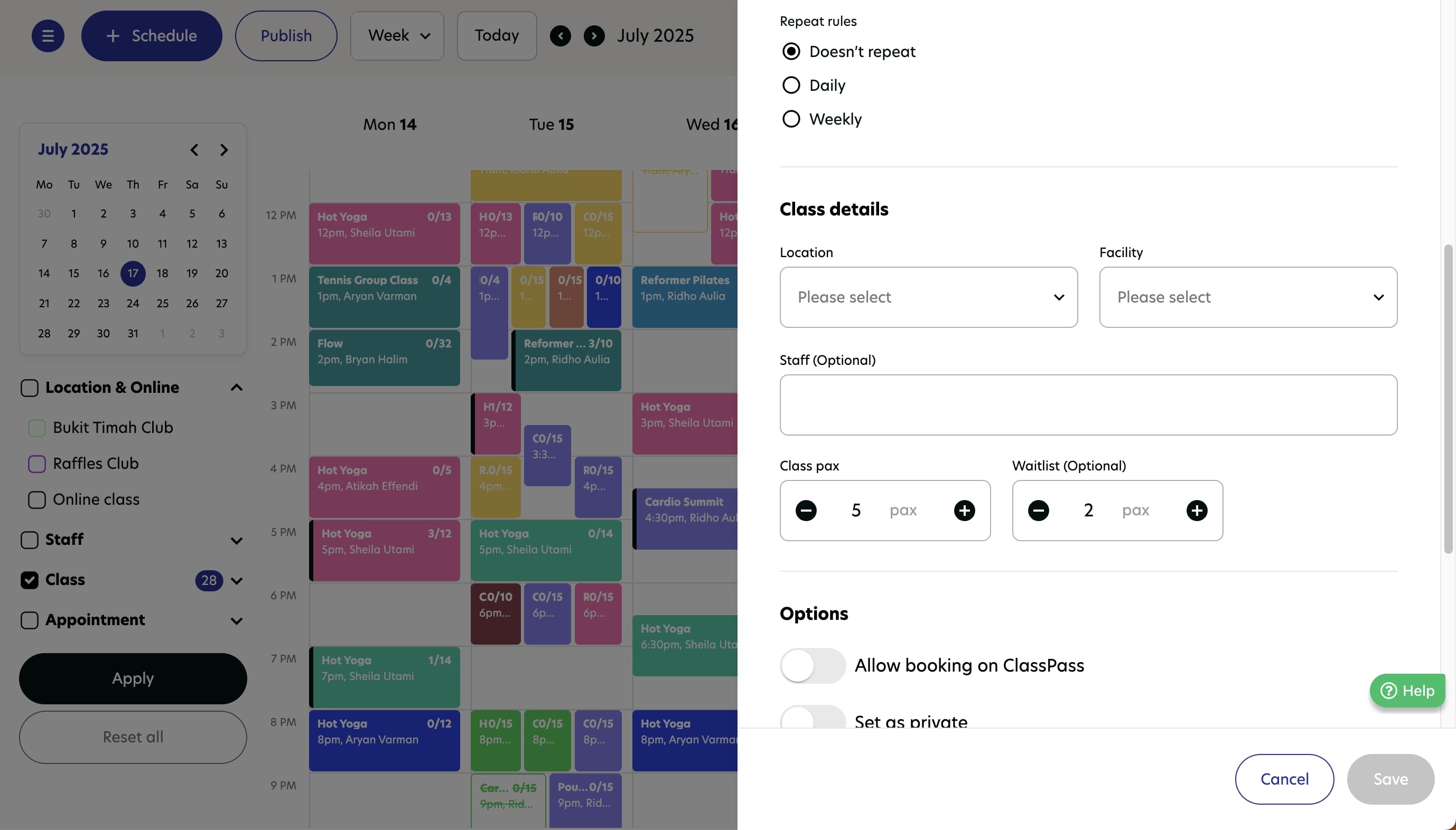How to maximize studio revenue with waitlists, upsells & packages in 2025
Let’s have a look at three tried-and-tested methods that keep existing clients happy and are relatively easy to implement for a studio business.

Source: Pexels
New customers bring fresh blood into your business. Yet, the acquisition process is expensive and often unpredictable. Client retention, on the other hand, is faster, more cost-effective, and ultimately more profitable.
Studios are service-based businesses with repeat experiences (monthly facials, weekly fitness classes, regular wellness treatments). Therefore, the more loyal customers you have, the stronger and more successful your business becomes.
Loyal customers are the engine behind sustainable growth — they can spend up to 67% more than new ones. So while you're busy attracting fresh faces, don’t overlook the value of those who already believe in your brand. Your competitors surely won’t.
To give you a head start, let’s have a look at three tried-and-tested methods that keep existing clients happy and are relatively easy to implement for a studio business.
1. Waitlists: Recover missed revenue without lifting a finger
Cancellations, no-shows, and fully booked slots without a system to capture overflow interest can drain your revenue.
OK, cancellations and no-shows are one thing, but how do fully booked slots impact my studio’s revenue?
Say you’re running a fitness studio. Your yoga classes are wildly popular — spots fill up fast, and people are practically battling for a chance to get in. You should not ignore this level of interest!
People will continue to try to get into your classes for a little while longer, but they’ll eventually reorient toward more available places. A waitlist gives you a direct way to contact and pull these patrons back on your side of the market — after all, they wanted you first!
It’s also a cheat sheet for when it’s time to grow your business. You already know your services are popular, but you may not know just how popular they are. A waitlist is a great indicator of that and provides valuable insight for making pricing, staffing, or scheduling decisions.
So, what are waitlists, and how do they work?
To put it simply, a waitlist is a record of people expecting to secure a spot once it becomes available. Popular salons, clubs, gyms, and similar establishments have at least one at any given moment in time.
But don’t imagine a crumpled, stained notebook by the front desk or sticky notes on the mirror in the entryway.
Today’s waitlists are fully automated systems that work in the background. The moment a member or client cancels a spot, the system will notify the next people in line until all the slots are filled. You don’t have to lift a finger.
With fitness software like Rezerv, clients can reserve a spot in line with just a few clicks. But then, once the client cancels their booking at the last moment, the next person moves up the waitlist and receives a notification or gets contacted by phone.
The greatest part? It can help you re-capture the earnings you’d most likely lose if the spot were left empty due to that last-minute cancellation.

Different studio establishments benefit from such a system. We’ve already covered fitness studios, but we can also include salons and spas, and even tattoo artists. Everyone in this sort of business stands to lose income from last-minute cancellations and no-shows.
Bonus Tip: Segment your waitlist by urgency, service, location, customer type (let’s say, first-timers vs. repeat clients), or other factors. Segmentation is actually the first principle of effective personalization. This way, you’ll personalize the customer experience and satisfy their particular needs and requirements.
How to implement waitlists effectively
A good waitlist captures demand, fills empty slots, and keeps clients engaged. All this happens in the background, so you don’t have to invest any mental effort.
If this is something you find appealing, here are a few steps for a successful implementation:
1. Say goodbye to manual lists
You may argue that manual notes work. Yes, they do (if you prefer havoc and error—kidding, sort of) and can be enough if you have 5–10 clients. But what if you have dozens or hundreds of those? You may simply lose customers (and revenues!) after one innocent mistake.
With Rezerv’s waitlist (which is fully automated, by the way), you can have lists for group classes. The system is versatile and easily adaptable to any service-based business needs.
2. Develop the waitlist law + etiquette
Do you follow the first-come-first-served principle? Is there a VIP-spot priority rule for your loyal clients? Do you set any confirmation deadlines before the spot goes to the next client in line?
Consider more nuances like these to shape your waitlist etiquette.
3. Make it insanely easy to use
No one would appreciate squandering time on your lengthy fill-in form. Ideally, compress all the information you want to get from your customers and let them make fewer clicks or taps. The fewer—the better.
Bonus Tip: How about outshining your competitors with an AI text-to-speech platform?
Of course, emails and SMS reminders are great, but why not use an AI-generated voice to make calls or send audio messages? On the one hand, it’s more engaging and interactive; on the other, it creates a more memorable experience. Just make sure to register your voice-over license so no one can steal your perfect AI voice (once you find it).
2. Upsells: Increase revenue without increasing volume
We all know the equation: more clients = higher revenues. But guess what? There’s a wiser move. Try to boost the value of each booking. How exactly? Upsell!
Think of upsells as the "Would you like to add avocado?" of your studio. Except, instead of guacamole, you’re offering enhancements that actually improve your client’s experience and your bottom line.
What is an upsell in a studio setting?
An upsell is a strategic offer that encourages clients to purchase a higher-tier service, add-on, or upgrade when they’re already planning to book.
This might be:
- Upgrading a basic haircut to a premium service with deep conditioning and scalp massage.
- Offering private training instead of a group class.
- Adding hot stone therapy to a massage.
- Extending a 60-minute session to 90 minutes for a reduced rate.
The key to a successful upsell? Make it relevant, valuable, and convenient.
The good news is that an upsell is easier to close than a new customer, since you’re working with someone who is already interested in your services. According to a recent study, existing customers are more interested in trying new products and spend 31% more than clients who’ve just started with you.
Plus, it’s a win-win situation: you boost revenue without investing in new clients, and the customers get a better experience with your services.
How to make upsells work for your studio
First, make sure you and your staff have an eye for spotting opportunities. You need to know when and how to suggest relevant upgrades. The upsell should be a genuine recommendation, not a pushy sales pitch.
Bonus Tip: Take a peek at your competitors. It’s one of the smartest ways to discover what’s working in your market without reinventing the wheel. You can use a competitor analysis tool to learn about their online strategy, but there are also sneakier ways, like becoming a mystery shopper or monitoring their social media channels.
Second, integrate upsells into your booking flow by showing relevant add-ons or upgrades when someone books a service.
For example, when a client books a facial, your system can suggest adding LED therapy or a serum boost. If the client is interested, they’ll add the extra service to their booking themselves. No awkward conversation, no manual input.
To increase the chance of success, pay attention to the language you’re using to present the upsell. Don’t just list what the upsell is; explain why it matters.
Instead of:
"Add-on: Aromatherapy $10."
Try:
"Enhance your massage with calming aromatherapy for deeper stress relief — just $10 extra."
Read also: 5 seasonal email marketing examples to inspire your next fitness campaign
3. Packages: Build loyalty, predict revenue, & reward commitment
Packages are bundles of prepaid services, like “Buy 3 massage sessions and the fourth is on the house.” Because people pay in advance, they are amazing tools for creating a more predictable income stream, reducing churn, and increasing client lifetime value.
In such cases, clients typically benefit from the reduced price. Plus, they get even more advantages. They don’t have to decide and pay several times for each product/service and develop a good and pleasant habit (suppose it’s yoga or fitness).
You need to know how to create bundles (or packages) that work. For instance, the best approach is the simple one that focuses on the value they provide for the customer.
For instance, a package should support a long-term goal, like better results, faster progress, or sustained self-care.
Instead of:
“ 8 fitness classes per month.”
Try:
“8-week body sculpt program.”
Also, keep in mind that packages are tools to reward commitment and motivate your customers. So don’t be too generous with the discounts. A 10–15% discount or a free bonus session is usually enough.
- Bad: Buy 10 classes, get 10 free (you’ve just halved your value).
- Good: Buy 10 classes, get 1 free + free guest pass or a custom t-shirt.
Another great approach to packages is to offer multiple levels of commitment, such as:
- Starter (3 sessions)
- Growth (5 sessions)
- VIP (10+ sessions with bonus perks)
This creates a natural upsell path and gives clients control over how much they invest.
How to design effective packages
A well-designed bundle nudges clients to actually use what they paid for, which is a win for them and your bottom line.
Here are three rules to keep in mind:
- Avoid open-ended packages with no expiration. It encourages procrastination, not commitment. Aim for 3 to 6 months' validity.
- Communicate the terms clearly. Include usage limits, cancellation rules, and booking conditions.
- Track usage and engagement. Someone not using their package? Re-engage them with a win-back email or call before they disappear.
Types of studios that benefit from packages
If your business runs on repeat visits and routines, packages are a great strategy for increasing customer loyalty and growth.
Here are some studio types where packages punch well above their weight:
- Fitness & yoga studios: Class packs, private coaching blocks;
- Beauty salons & spas: Facial programs, hair care packages, seasonal specials;
- Tattoo & piercing studios: Design + ink packages, aftercare kits included;
- Martial arts & dance: Belt progressions, choreography packages;
- Massage clinics: Recovery bundles, wellness maintenance plans.
FAQ
1. How to introduce upsells without annoying clients?
Keep them relevant and well-timed. Wait for clients to be already engaged with a service you're offering, and only then provide the option of an upsell.
2. How many sessions are in a package?
There are no strict numbers. However, 5–7 sessions would be just enough to drive motivation yet not too much to scare clients away. But make sure to set an expiry date to evoke FOMO and a sense of urgency.
3. What studios benefit most from these strategies?
The direct answer would be any studio with recurring appointments or group classes. If it’s a beauty salon or a tattoo studio, they can serve only a limited number of customers. That’s why no-shows or cancellations may hurt the bottom line. And that’s why waitlists are the most beneficial for them.
Read next: 7 digital marketing tactics for fitness studios in 2025
